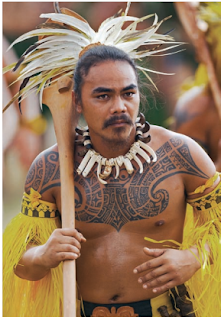 |
| Rock Garden, Ryoanji Kyoto |
Zen Dry Gardens was a form of art, unlike most others. It
wasn’t a form of painting or drawing and it was more of a piece of
architectural masterwork. Monks have used these in their attempts to reach
enlightenment. “In addition to daily meditation, they engaged in manual labor
to provide for themselves and maintain their temple properties” (Stokstad,
832). The trees and plants growing outside the actual garden are still part of
the garden as they contribute to the scenery. This is called “borrowed
Scenery”. These gardens were prominent
in the fifteenth century and were primary in Japan. Later on, Chinese art began
to influence the way people made the gardens to create a more art-like setting.
The Rock Garden in Ryoanji, Kyoto has rocks appearing out of the floor. Then
the sand around it is raked into a circular pattern as if disseminating from
the rock. This represents the ocean and its many islands that come out of the
ocean floor. Others see it as mountains
that rise into the sky or the stars in the sky. The ability of these gardens to
be interpreted in many ways is part of the art in the sense that everyone can
see it differently. Many people in today’s modern society still make zed
gardens for themselves to relax and meditate.
 |
| Marquesas Dancer |
The Polynesians were well known for tattooing. The Marquesas
Islands were the most tattooed of the Polynesians. To the Polynesians, blood was a sacred
substance and thus at the age of 18 -30 a young man would get their tattoos
(tattoos piece skin causing bleeding).
These tattoos were sacred and had meanings to the individual. They would
represent status, family, accomplishment or other things that occurred in the
individual’s life. Women could also get
tattoos. They had special houses in which the ceremony would be done, and the
tattoos would then be given. It became a major part of the Marquesas culture.
They take pride in their tattoos.
Similar traditions/tattoos can be seen in that area of the world such as
Samoa, Hawaii, and other islands.
 |
| Machu Pichu, Peru Inca 1450-1530 |
Machu Pichu was a city in Peru for the Inca civilization.
During its time, it was a city, but now it is one of the world's most famous
pieces of architecture. Stokstad
describes the Machu Pichu’s surrounding, “At almost 8,000 feet above sea level,
it straddles a ridge between two high peaks in the eastern slopes of the Andes
and looks down on the Urubamba River” (Stokstad, 858). When looking at the way
the city was built, it was well thought out. It had a set place for meetings
for leaders. It also was set up so that the views of the surrounding areas were
easily accessible, and the view was beautiful. The stones were cut and fit
nearly perfectly with one another to create strong walls. The walls used only
frictional force to hold it together since they didn’t have access to modern
glues like mortar. It was phenomenally
constructed for both beauty, practicality, and protection.
 |
| Wampum Belt: William Penn's Treaty With Deleware |
The Wampum is mainly associated with early Americans. “The
Iroquois and Delaware peoples used wampum to keep records (the purple and white
patterns served as memory aids) and exchanged belts of wampum to seal treaties”
(Stokstad 861). Wampum looks as if it was a belt that was worn around the
waist. It is also very flashy as the beads and shells shine. Stokstad explains
that few wampums used for treaties are still in existence. The one in the
picture shown was from when the Delawares ceded the land that we now know as
Pennsylvania. The figure on the Wampum shows two people holding hands. This
could represent a form of equality and agreement. From history, we then find
out that this treaty failed as the Quakers and Delawares eventually began to
fight and have a violent relationship once again. Either way, this is a very
important part of American history and tradition.
 |
| Korambo, 20th century, Kinbangwa Village, Sepik River, Papua New Guinea |
The Korambo is a ceremonial house that was used in Papua New
Guinea. This house is made only for the men. It is a way for the men to have
group sessions without the interference of women. They would be able to plan
and have a clan identity that was only for the men. When building the Korambo
every step of the process is associated with a ceremony that is held early
while the women and other boys not in the cult are sleeping. One of the
ceremonies can even last up to 6 months and consisted of dancing for long hours
throughout the night. These ceremonies are very similar to other cultures where
they have ceremonies for boys who reach an age of maturity and then become men.
Once the boys have reached this point, they will be allowed to enter into the Korambo,
meaning that they are now men.
Citation
Stokstad, Marilyn, and Michael Watt Cothren.Art History.Sixth ed,.II, Pearson,2018.
No comments:
Post a Comment